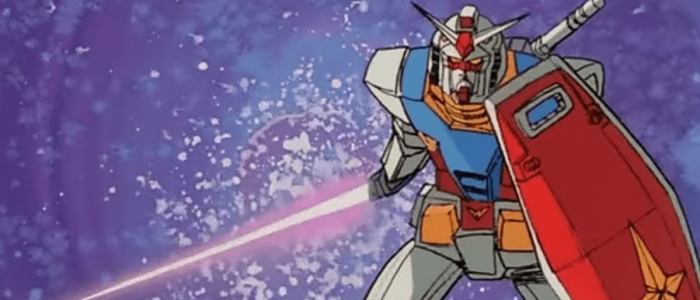
(Welcome to Ani-time Ani-where, a regular column dedicated to helping the uninitiated understand and appreciate the world of anime.)
The Seinfeld is Unfunny effect is a trope that refers to the feeling of watching a work that is so influential that you recognize everything it once pioneered, but are no longer impressed by it. The jokes aren’t funny anymore, and you see the twists coming a mile away. Some works, however, manage to live up to their reputation and impress even decades later.
The original Mobile Suit Gundam is one such work.
We’ve covered this massively popular franchise once before, but now the show that started it all is finally available to stream. So before Netflix makes a live-action movie, we’re heading back to the beginning to explore the show that kickstarted what would become Japan’s answer to Star Wars; a franchise as iconic as it is inaccessible given how many spin-offs, sequels, prequels, and myriad alternate universes it generated.
The show takes us to the tail end of the One Year War, a conflict between a unified Earth Federation and a group of rebels from space colonies known as the Principality of Zeon. The story focuses on a teenage boy named Amuro Ray whose father helps create a new mobile suit called (you guessed it) Gundam to fight Zeon’s mobile suits. Amuro inadvertently becomes the sole pilot of the titular suit and gets sucked into the war with a group of child soldiers aboard a giant spaceship. Char Aznable, a brooding flying ace also known as the Red Comet, becomes Amuro’s rival while keeping a secret mission to reclaim his honor.
Whether you want to experience the entire 43-episode show or watch the condensed seven-hour movie trilogy, let’s get in the robot and explore the show that changed the mecha genre forever.
What Makes It Great
From the start, you get the feeling that you’re watching a small chapter in a much larger epic saga. Contrary to the grand operatic battles, the command center intrigue, and the throne room machinations akin to Legend of the Galactic Heroes, creator Yoshiyuki Tomino decides to focus the action primarily on the contained story of the spaceship White Base and its crew. We occasionally glimpse what command has in store and only get rare wide shots of the space battle, giving us a child soldier’s perspective of events they have no control over.
And when I say child, I mean it. The crew of White Base is composed entirely of teenagers, young adults, and a few kids, as they were the only survivors of an attack in their home colony. Gundam was very clearly created by people who grew up in a post-WWII Japan, having seen countless adults go out to fight and never return, leaving the young generation to pick up the pieces. We see how they try their best to distract themselves from the horrors that surround them, and how they are forced to grow up because of it.
Watching Gundam today, you can see how the characters influenced countless archetypes in young adult fiction, with Amuro serving as a clear template for Neon Genesis Evangelion‘s Shinji Ikari; both are teenagers tasked with manning an incredible weapon and charging into war. Meanwhile, Char’s backstory and pseudo-face-turn bring to mind Avatar: The Last Airbender and Zuko’s redemption arc.
What It Adds to the Conversation
Arguably Gundam‘s greatest contribution to the mecha genre is its treatment of war and its human cost. No matter how cool the Gundam fights are — if watching Jedi fights in Star Wars is cool, try giving a lightsaber to a giant robot — the show always makes sure to cut away to the devastating losses that surround the cool moments. None of the main characters make it to the other side unscathed as the death and violence start taking a heavy toll on our incredibly young ensemble.
This is why the show’s focus on a small group of common soldiers rather than commanders and leaders is so effective: it shows us that the ones doing the fighting and the dying are just regular people. That this was done on a kids’ show back in the 70s at a time when anime (like American cartoons during the ’80s) was mostly made to sell toys is still an impressive achievement.
Gundam‘s anti-war message is also delivered through the show’s weirdest and most sci-fi concept — the Newtypes, humans who have evolved to adapt to life in space with heightened senses. Though this first series doesn’t do much with the concept, the few explanations we get hints at Tomino’s ideas that humanity will eventually evolve to be capable of understanding one another, therefore avoiding conflict. It’s not entirely unlike Evangelion‘s Human Instrumentality, and it complements Gundam‘s anti-war themes nicely as the Newtypes are mostly used as weapons of war by people in charge with older and more limited ways of thinking.
Why Non-Anime Fans Should Check It Out
Mobile Suit Gundam is the quintessential anime franchise and this first series is the original real robot show. An epic yet intimate coming-of-age story in the middle of a galactic war with incredible action, fantastic world-building, and relatable characters. Whether you’ve never seen a mecha anime before, are looking for a more grounded space opera, or want to see the show that birthed an entire sub-genre, now’s as good a time as any to enter the Universal Century timeline and watch some Gundam.
Watch This If You Like: Star Wars, Neon Genesis Evangelion, Giant robots wielding laser swords, Code Geass.
***
Mobile Suit Gundam is streaming on Crunchyroll and Funimation. The Gundam compilation trilogy is streaming on Netflix.
The post ‘Mobile Suit Gundam’ More Than Lives Up to Its Influential Reputation as One of the Anime Greats appeared first on /Film.
0 Comments